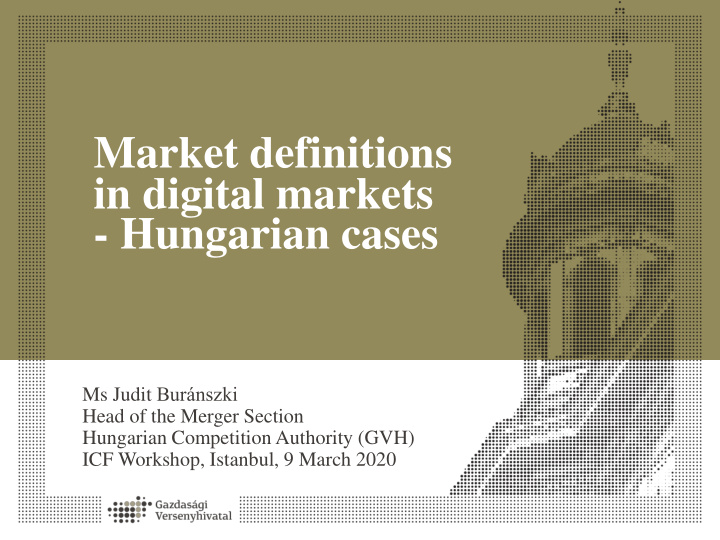



Market definitions in digital markets - Hungarian cases Ms Judit Buránszki Head of the Merger Section Hungarian Competition Authority (GVH) ICF Workshop, Istanbul, 9 March 2020
Outline • Introduction Key features of digital market Two/multi-sided platforms • Hungarian examples Online booking services – Szallas.hu/Utazok.hu Online insurance intermediaries – Netrisk/Biztositas.hu Retail of electrical goods via online stores – eMAG/Extreme Digital • Conclusion
Key features of digital markets • Fast-moving nature • Low marginal and distribution cost • Economies of scale and scope • Network effects • Zero- (monetary) price offers • Importance of data • Two/multi-sided platforms • Varied and evolving business models
Two/multi-sided platforms Single-market approach vs multi-markets approach In two-sided non-transaction markets, two (interrelated) markets should be defined. In two-sided transaction markets, only one market should be defined. Market definition has to take into account the degree of multi- and single-homing by platform users. Effects of multi-homing can be different when competition is in the market rather than for the market.
Szállás.hu/Utazok.hu (1) Acquisition of sole control over Utazok.hu by Szallas.hu Both companies operate online hotel booking platforms focusing on domestic travellers Procedure : • April 4, 2019: Transaction notified • June 4, 2019: Phase I unconditional clearance decision adopted
Szállás.hu/Utazok.hu (2) Separate product market for online booking services • The market for online booking services is a two-sided transactional market • Users on both sides of the market are multi-home Whether the market should be further segmented depending on the nationality of consumers ? • Substitutability between international and national site • Boundaries are blurred as many companies offering accommodation use a mixed strategy whereby it makes no difference between the consumers Question left open ; it had no effect on the outcome
Netrisk/Biztositas.hu (1) Acquisition of sole control over Biztositas.hu by Netrisk. Insurance intermediates, both companies operate online insurance broker platforms Procedure : • March 5, 2019: Transaction notified • December 12, 2019: Phase II unconditional clearance decision adopted
Netrisk/Biztositas.hu (2) The market for insurance intermediate services is a two-sided transaction market Whether online and offline insurance intermediate services belong to the same product market? Result of the market investigation was mixed • Role of online purchases are significantly different in each insurance segment • Increasing number of customers use online insurance broker platform to compare prices, but later use other sales channel • The boundaries between the two sales channel are blurred many brokers use mixed strategy Question left open since ; on any plausible definition, no competition problems arise
Netrisk/Biztositas.hu (3) Whether the market should be further segmented by insurance types ? • Strong indicates that intermediation of life insurances and non- life insurances are different, but that question was not relevant, because the parties do not purchase life insurances • Considering non-life insurance intermediate services no distinction between different insurance types Insurance companies other distribution channels (especially its own websites) exert very strong competitive pressure on insurance intermediate services
eMAG/Extreme Digital (1) Acquisition of sole control over Extreme Digital over eMAG. Online retailers of electronic goods Procedure : • March 25, 2019: Transaction notified • October 17, 2019: Phase II unconditional clearance decision adopted
eMAG/Extreme Digital (2) Online and offline retail of electrical goods belong to the same product market • Range of products available online and offline is similar (or online is larger) • Evolution of retailer business models towards „omnichannel” marketing • Uniformisation of online and offline price • Consumers habits No distinction between the type of goods
Conclusion • Case-by-case assessment • Markets are fluid and fast-moving • Market definition and market share has lower importance than traditional markets • More dynamic analyses • Greater focus on competition pressure from other sales channels
Thank you! Ms . Judit Buránszki buranszki.judit@gvh.hu
Recommend
More recommend